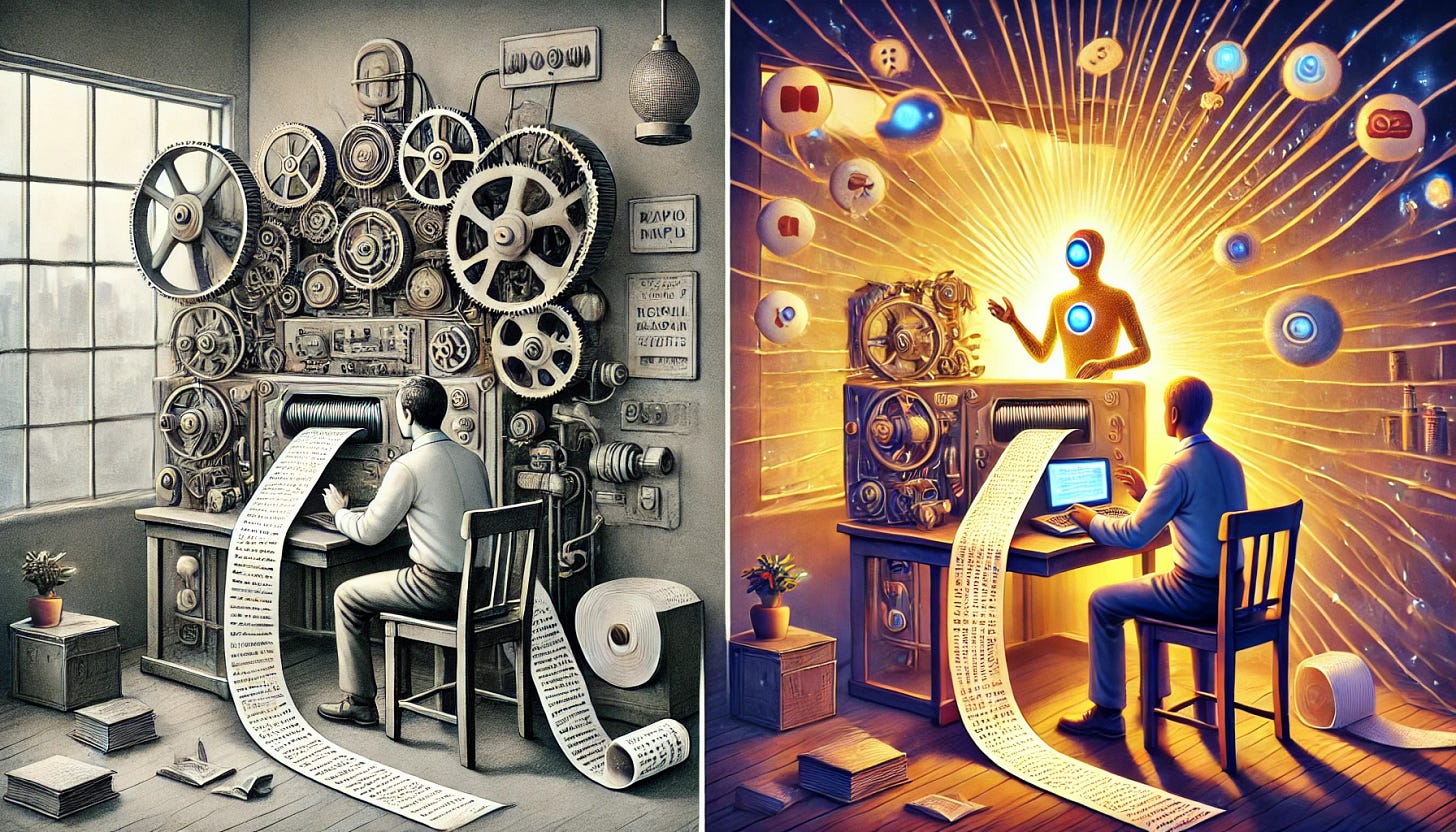Transactional vs. Conversational Visions of Generative AI in Teaching
AI as a Printer, or AI as a Thought Partner
As educators experiment with integration of AI into the teaching and learning experience, our perspective matters. This post explores two fundamentally different mindsets: seeing AI as merely a product generator versus viewing it as a thought partner. While this distinction may not be revolutionary to everyone, articulating it has transformed my own approach to AI in education, and I share it for those who might find themselves at a similar crossroads in their thinking.
The Fundamental Question
As instructors consider whether and how to incorporate Generative AI into their teaching, they are confronted with a fundamental question: What is AI's role in learning? Is it merely a product-producing machine that substitutes for students' thinking, or can it serve as a meaningful interlocutor that helps students refine their ideas and sharpen their critical thinking?
This question has profound implications. If we see AI as nothing more than an output generator, then using it to complete writing assignments can only be understood as a shortcut or a form of cheating—something that weakens rather than strengthens human thought. If AI replaces a student's reasoning and communication skills, then it is no different than a calculator replacing basic arithmetic skills before students truly understand how numbers work. In this view, AI contributes to intellectual atrophy, undermining the very skills writing instructors are trying to cultivate.
However, if we shift our perspective and consider AI as a conversation partner—someone with broad knowledge, adaptable roles, and the ability to challenge and refine students' ideas—then a different picture emerges. AI ceases to be a mere product generator and becomes an active participant in the learning process. This perspective is where I find myself, and it has fundamentally changed how I think about writing instruction in the AI era.
The Moment of Realization: Two Ways of Seeing AI
I first articulated this contrast after a long conversation with a fellow writing instructor. We had spent the afternoon discussing philosophy of language, theories of mind, and their relationship to Generative AI. As we wrapped up, still deep in discussion, it suddenly struck me: there are two fundamentally different mindsets about AI.
One sees AI as transactional—a tool that simply delivers a product. In this model, students provide input, and AI generates an output, much like a vending machine dispensing a snack. This is the mindset that fuels anxiety over AI detection, Turnitin scores, and honor violations. It is also the mindset that limits the potential of AI to mere automation.
The other sees AI as relational—a partner in thought and learning. In this model, AI is not just spitting out generic papers but engaging students in meaningful dialogue, prompting them to clarify their ideas, challenge assumptions, and think more deeply. This is the model that excites me.
I recognize that this contrast between transactional and relational approaches to AI isn't a groundbreaking revelation for everyone. Many educators and AI researchers have long understood this distinction. For instance, Nick Potkalitsky recently proposed thinking of GenAI as an "inquiry tool rather than a text generator.” My colleague Anna Mills, a fellow California Community College writing teacher and GenAI expert who has presented at Ventura College where I teach, captures this distinction brilliantly in a simple formula:
When it comes to learning,
👍 Yes to AI for input
👎 No to AI for output
For me, articulating it clearly was a personal breakthrough that changed how I approach AI in education. I share it here for those who, like me, might be working through their own understanding of AI's role in learning.
Visualizing the Contrast: AI as a Printer vs. AI as a Thought Partner
The images above illustrate this contrast. In the first, outdated view, AI functions like a mechanical printer. The human user types in a prompt, and a long strip of text mechanically rolls out. There is no engagement, no conversation, just a one-way transaction. The rigid, impersonal nature of the interaction reinforces the idea that AI is simply a content-generation tool—nothing more.
But this second image tells a different story. Here, AI is not a printer but a luminous, abstract figure engaged in dialogue with the human. Ideas and energy flow between them, and, crucially, the human's own thinking is being actively shaped and enriched by the exchange. This is not about passively receiving information—it is about co-creating knowledge. The person is inspired, expressive, and fully engaged, showing that the real value of AI lies not in replacing human thought but in amplifying it.
This illustration further emphasizes the conversational nature of AI as a thought partner. The rich visual language of colors, symbols, and flowing energy represents the dynamic intellectual exchange that can happen when we approach AI as a collaborator rather than merely a tool.
Teaching with AI: A Real-World Example
This shift in mindset for me was at least partially prompted by playing around with Brisk Boost for Students, a tool designed to integrate AI into learning in a way that prioritizes engagement and critical thinking. According to its website:
With Brisk Boost, educators can turn any online resource into an educational, AI-powered activity and then monitor student learning and engagement in real-time. Brisk Boost creates a safe environment for students to leverage AI in their learning while giving educators valuable insights - bridging the gap between traditional teaching methods and cutting-edge educational technology.
I tested it by creating an "Exit Ticket" activity (a quick assessment at the end of a lesson) based on a video about teaching with AI. Try it out if you’d like. With just a few clicks, I installed the free Chrome extension and transformed the video into an interactive AI-driven discussion.
The experience was striking. The AI dialogue box that appeared beside the video did not simply regurgitate information—it pushed me to clarify my own thinking about AI in the classroom. The AI-driven chat identified four learning objectives (which I could modify in instructor mode) and guided me through a structured conversation, ensuring I engaged with each key concept. But this was not a surface-level quiz or a rote comprehension check. The AI required me to provide detailed, thoughtful responses, and it continued the conversation until I had truly demonstrated understanding.
While the tool has limitations—it works best with clearly defined learning objectives and sometimes struggles with highly nuanced topics—it demonstrated how AI can deepen rather than shortcut learning.
This experience reinforced what I already suspected: the most powerful use of AI in education is not to produce content but to provoke deeper engagement. The AI did not write my thoughts for me—it drew them out of me.
Rethinking Writing Instruction in the AI Era
So how should we, as writing instructors, think about AI? If we accept the transactional model, then AI represents only a threat—a shortcut, a way to bypass thinking, a tool that undermines the writing process. If, however, we embrace the relational model, then AI can be an invaluable pedagogical ally. It can serve as a discussion partner, an intelligent tutor, and a creative stimulant, helping students refine their arguments, clarify their reasoning, and develop their voice.
This is the mindset I want to cultivate in my students. I don't want them to see AI as a substitute for their own thinking. I want them to see it as a tool that challenges and refines their ideas, much like a good teacher or a thoughtful peer reviewer would. I want them to approach AI not with the question, "What can you write for me?" but rather, "How can you help me develop my ideas?"
This shift is crucial. AI will not go away, and its capabilities will only grow. If we frame our students' relationship with AI as adversarial—something to detect, police, and punish—we miss an opportunity to teach them how to engage critically with it. But if we teach them to use AI as a thought partner, we give them a skill that will serve them long after they leave our classrooms.
Call to Action
As writing instructors, we have a choice in how we frame AI for our students. I invite you to:
Experiment with AI as a conversation partner yourself before introducing it to students
Design assignments that leverage AI's strengths as a thought partner rather than trying to "AI-proof" your existing assignments
Explicitly teach students how to engage in productive dialogue with AI—how to ask good questions, challenge AI's assumptions, and use it to refine rather than replace their thinking
Share your experiences, both positive and negative, with colleagues to build our collective understanding of effective AI integration
As writing instructors, our perspective on AI shapes how our students will use it. When we view AI as a conversation partner rather than a paper mill, we transform what could be a threat into a powerful ally. Our students will use AI regardless of our policies. The real question is whether they'll use it thoughtfully, critically, and ethically—skills they can only develop if we guide them to see AI as I now do: not as a replacement for thinking, but as a catalyst for deeper thought.
This post was created in collaboration with AI tools, reflecting my commitment to understanding both the potential and limitations of AI in writing instruction.





This is exactly how I’ve reframed my approach to integrating GenAI tasks with students since I took a course with Dr. Jules White from Vanderbilt and Barb Oakley. The learning and tutoring opportunities for students are fruitful and often result in our discussions about writing becoming more detailed.
Great article!
This aligns well with something I wrote a while ago about the transactional nature of education (and why we need to move away from it).
https://open.substack.com/pub/aigoestocollege/p/beyond-grades-transitioning-from